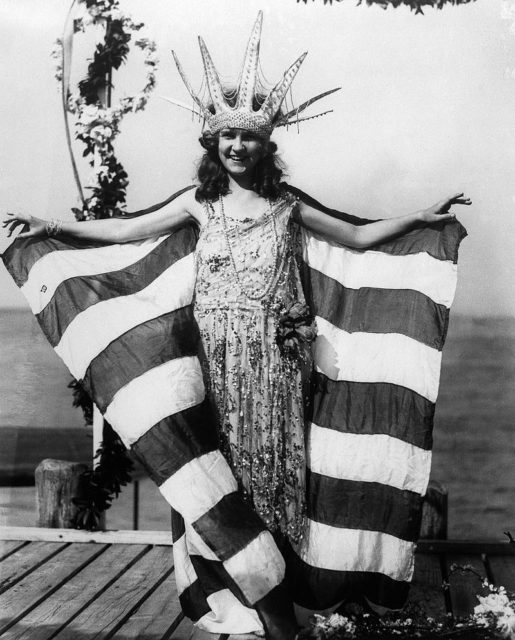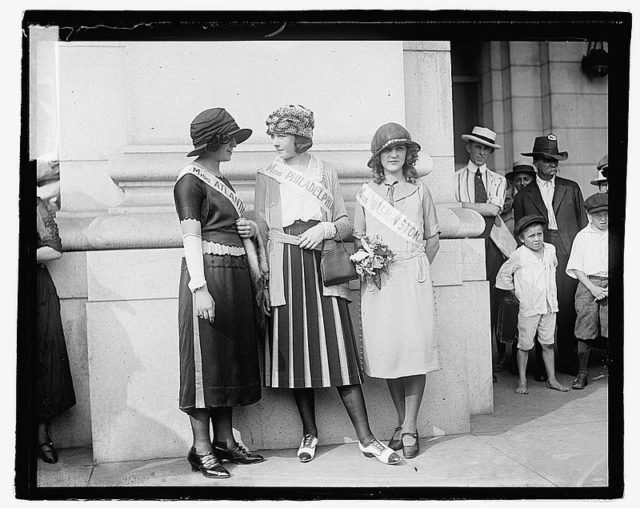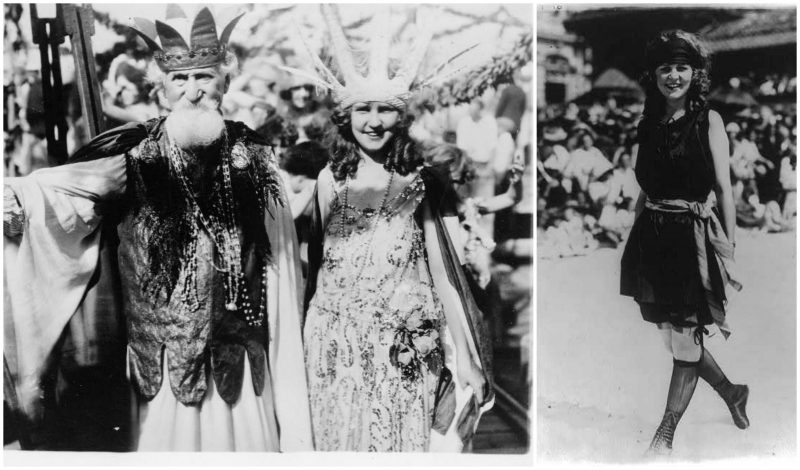In September of 1920, Atlantic City businessman Conrad Eckholm, owner of the Monticello Hotel, put on a festival designed to keep tourists in town for the two weeks following Labor Day.
The “Fall Frolic” was a city festival that culminated in a rolling chair parade. This event featured local young women riding on decorated wicker seats that accommodated at least two people and had two rear wheels and one front wheel. Afterward, a costume party was held on the pier. The wicker seats were so popular that they began to be used on the Boardwalk for the entire season.

Over the winter, newspaper publishers had a conference; Harry Finley suggested having a popularity contest for young ladies from several cities, with the winner receiving a trip to Atlantic City. The local newspaper would provide the contestants’ wardrobe. The Hotelmen’s Association approved the idea, and the contest was set for the 1921 Fall Frolic.
On September 8, 1921, almost one hundred thousand spectators gathered at the Boardwalk to see contestants from Washington, DC, Pittsburgh, Philadelphia, Harrisburg, Ocean City, and Newark.
The festivities opened with Father Neptune and his attendant mermaids (the contestants) arriving on a shell barge to the whistles of trains and factories, the ringing of church bells, and folks in the crowd.

States had their own tents from which judging took place, and a large dance platform was erected on the beach. Activities such as boat races, a vaudeville show, fireworks, and Neptune’s Frolique, a costume ball at Steeplechase Pier, filled the afternoon and evenings.
A.R. Rivero, author of Live From Atlantic City: The History of the Miss America Pageant Before, After, and in Spite of Television wrote, “Also part of the scene were thousands of sea nymphs in last minute editions of the 1921 surf apparel-solo attire with nude limbs beneath that made the lifeguards, pinch hitting as beach censors, blink, gasp – and then remember they were officially blind until midnight.”

The pageant lasted two days, with categories of amateur and professional in the Inter-City Beauty Contest and the Inter-City Bathers’ Review. The winner of each category would compete against each other for the Golden Mermaid trophy and $100. The contestants wore afternoon attire and were judged by the public for 50 percent of the final score. The other 50 percent was determined by assigned judges. Personality was a large part of the competition, and the public was allowed to question each entrant to get to know her better. Later that evening, contestants were presented on the stage of the Keith Theater on the Garden Pier.
Continues below
The winner, sixteen-year-old Margaret Gorman from Washington DC, won the Golden Mermaid trophy and $100. Everyone expected Gorman would defend her title the next year, but because another woman had won the title of “Miss Washington, DC,” she was crowned as Miss America.
She is the only Miss America who had to wait for her crown until the end of the year. Gorman has stated that she was never excited about being Miss America and found the honor to be a bore.

The Miss America pageant changed drastically over the following years. Contests from 1921 through 1927 took much the same form as the first one, but new rules and the evening gown competition were added after 1924. It was ruled that only single women could compete, and the winner could not compete again. By 1927 the pageant had disappeared.
It was revived in 1933 but, due to the Great Depression, it was a very low-key event. Several contestants were eliminated because they were not residents of the state they represented.
In 1935 the talent competition was introduced, and in 1939 the award for Miss Congeniality began.
During World War II, the sponsors wanted to cancel the show. But they were warned by Madison Square Gardens in New York City that if Atlantic City stopped the pageant, New York would resume the competition and the pageant would stay in that city. Rather than lose the entire show to another city, organizers came up with the idea of Miss America selling war bonds across the nation.
In 1945, the first college scholarship was awarded and has since become one of the primary emphases of the pageant.
On Saturday, September 11, 1954, the pageant was broadcast on television for the first time, and twenty-seven million people tuned in. The following year, Bert Parks began his long association with the Miss America pageant. The year 1959 saw representation from every state in the Union for the first time. In 1970, the first black woman entered the pageant – Cheryl Adrienne Browne of Iowa. It wasn’t until 1983 that a black woman, Vanessa Williams, won the title, but she had to resign after tabloids ran evocative pictures that had been taken of her.

In 1990 the pageant officials decided each contestant must have a cause to champion. Debbye Turner, the 1990 winner, chose “Motivating Youth to Excellence”, and in 1991 Marjorie Judith Vincent, Miss Illinois, promoted awareness of domestic violence. In 1994 Alabama’s Heather Whitestone was the first disabled person to wear the crown.
Some winners went on to show business careers, including Bess Myerson, Lee Meriwether, Vanessa Williams, Phyllis George, Betty Buckley, and Mary Ann Mobley.
